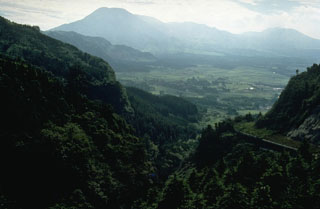Report on Asosan (Japan) — September 1989
Scientific Event Alert Network Bulletin, vol. 14, no. 9 (September 1989)
Managing Editor: Lindsay McClelland.
Asosan (Japan) Continued tephra emission
Please cite this report as:
Global Volcanism Program, 1989. Report on Asosan (Japan) (McClelland, L., ed.). Scientific Event Alert Network Bulletin, 14:9. Smithsonian Institution. https://doi.org/10.5479/si.GVP.SEAN198909-282110
Asosan
Japan
32.8849°N, 131.085°E; summit elev. 1592 m
All times are local (unless otherwise noted)
Eruptive activity (from 891 vent in Naka-dake's Crater 1) began on 16 July, and by 5 October, 14 ash eruptions had been recorded (table 4). During clear weather in September, vent 891 (first seen 11 June; see SEAN Bulletin 14:06) was observed emitting an ash-laden plume almost daily. On the 27th from 0900 to 1330, continuous ash emission produced a 3000 m plume (the highest of the month) that deposited ash about 55 km E. [Daily ashfall at Aso Weather Station, 1 km WSW of the volcano, in September 1989 (in g/m2) was as follows: 5 (73), 6 (1,188), 8 (18), 9 (9), 11 (11), 16 (57), 17 (48), 20 (11), 24 (306), 30 (1,000).]
Table 4. Plume heights and colors for eruptions 1 July-5 October 1989. The Japan Meteorological Agency uses the term "eruption" to distinguish more voluminous ash ejections from low-level continuous ash emission. Data courtesy of JMA.
| Date | Time | Color | Plume Height (m) |
| 16 Jul 1989 | 1354 | -- | 2,500 |
| 16 Jul 1989 | 1603 | -- | 1,000 |
| 16 Jul 1989 | 1625 | -- | 1,000 |
| 24 Jul 1989 | 1620-1720 | -- | 2,000 |
| 14 Aug 1989 | 1050 | Blackish gray | 1,000 |
| 04 Sep 1989 | 1540 | Grayish white | 2,500 |
| 04 Sep 1989 | 1725 | Grayish white | 2500 |
| 07 Sep 1989 | 1650-1840 | -- | 3,000 |
| 16 Sep 1989 | 1400-1450 | -- | 2,200 |
| 27 Sep 1989 | 0900-1330 | -- | 3,000 |
| 29 Sep 1989 | 0330-1610 | Grayish white | 1,500 |
| 29 Sep 1989 | 1650-1930 | Grayish white | 600 |
| 30 Sep 1989 | 0925-1830 | Grayish white | 1,500 |
| 01 Oct 1989 | 1245-1630 | Grayish white | 1,000 |
| 02 Oct 1989 | 1205-1650 | Grayish white | 1,000 |
Red glow from vent 891 was seen almost daily from the rim of the crater. A maximum September vent temperature of 535°C was measured by an infrared radiation thermometer on the 6th. During a field survey 26-27 September, burning gas from the vent reached 50 m height.
The number of isolated volcanic tremor episodes (recorded by a seismometer 0.8 km W of Crater No. l) increased in September, with 720 events on the 18th and 702 on the 27th (figure 15). On the 26th, the month's largest tremor amplitude, 7.7 microns, was recorded.
 |
Figure 15. Seismicity at Aso, 1 March 1988-2 October 1989. Daily number of isolated tremor episodes (top); daily maximum and average amplitudes of volcanic tremor episodes (bottom). Courtesy of JMA. |
Geological Summary. The 24-km-wide Asosan caldera was formed during four major explosive eruptions from 300,000 to 90,000 years ago. These produced voluminous pyroclastic flows that covered much of Kyushu. The last of these, the Aso-4 eruption, produced more than 600 km3 of airfall tephra and pyroclastic-flow deposits. A group of 17 central cones was constructed in the middle of the caldera, one of which, Nakadake, is one of Japan's most active volcanoes. It was the location of Japan's first documented historical eruption in 553 CE. The Nakadake complex has remained active throughout the Holocene. Several other cones have been active during the Holocene, including the Kometsuka scoria cone as recently as about 210 CE. Historical eruptions have largely consisted of basaltic to basaltic andesite ash emission with periodic strombolian and phreatomagmatic activity. The summit crater of Nakadake is accessible by toll road and cable car, and is one of Kyushu's most popular tourist destinations.
Information Contacts: JMA.

